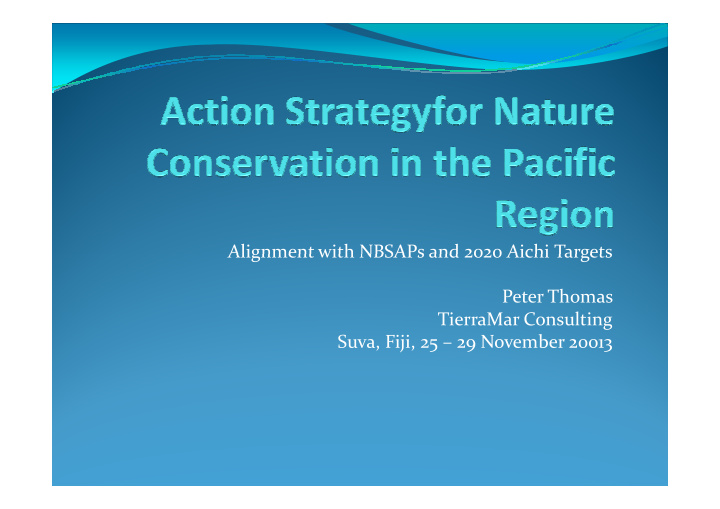



Alignment with NBSAPs and 2020 Aichi Targets Alignment with NBSAPs and 2020 Aichi Targets Peter Thomas TierraMar Consulting Suva, Fiji, 25 – 29 November 20013
Background to the Action Strategy � Product of successive Pacific Conferences on Nature Conservation and Protected Areas (1975 – 2007) � a call to action on the conservation of the Pacific � a call to action on the conservation of the Pacific islands environment � significant contribution to region’s natural and cultural heritage conservation capacity
Achievements � advocated the community based protected area management approaches � encouraged governments, NGO’s and community partnerships � encouraged governments, NGO’s and community partnerships � mainstreaming of environmental and nature conservation solutions � identified regionally appropriate conservation tools � promoted healthy environments and strong socially, culturally and economically sustainable Pacific communities linkage.
2008 – 2012 Action Strategy Addressed the need for: � an improved sense of ownership and commitment � linkage to NBSAPs to reflect the scope and priorities of the PICTs priorities of the PICTs � focus on shared priorities where regional collaboration can make a difference � linkages with regional and international initiatives e.g. Island Biodiversity Programme of Work
Action Strategy 2008 -2012 GOALS Environment The biodiversity and natural environment of the Pacific are conserved conserved Economy Nature conservation and sustainable resource use are integral parts of all island economies Society Pacific peoples are leading activities for the sustainable use of the natural resources and the preservation of cultural heritage for the benefit of present and future generations
Action Strategy 2008 -2012 Objective 1 Ensure conservation has a development context that recognises, respects and supports sustainable livelihoods and community development aspirations Objective 2 Objective 2 Identify, conserve and sustainably manage priority sites, habitats and ecosystems Objective 3 Protect and recover threatened species and species of ecological, cultural and economic significance Objective 4 Manage threats to biodiversity, especially climate change impacts and invasive species
Key Findings of Review Targets � the absence of specific and measurable targets against which to assess of the outcomes of Action Strategy affects its strategic utility and accountability. � the next Strategy should attempt to embrace a higher level of regional or international targets which also reflect the NBSAP priorities of Pacific Island countries. � The CBD Aichi 2020 global targets for biodiversity conservation and protected areas are recommended for consideration for inclusion in the next Action Strategy.
Action Strategy 2008 -2012 Principles of Nature Conservation in the Pacific Code of Conduct � eight guiding Principles � Principles are a Code of Conduct to which all parties involved in Principles are a Code of Conduct to which all parties involved in Pacific conservation are urged to adopt and commit to � define the critical components for delivering nature conservation effectively � represent the best practice for designing, establishing, implementing and sustaining conservation programmes.
Action Strategy 2008 -2012 � Principle 1. Community Rights � Principle 2. Conservation from a Pacific Perspective � Principle 3. Ownership of Conservation Programmes � Principle 4. Financial Sustainability Principle 4. Financial Sustainability � Principle 5. Good Governance � Principle 6. Coordination � Principle 7. Capacity Development � Principle 8. Accountability
Recommend
More recommend